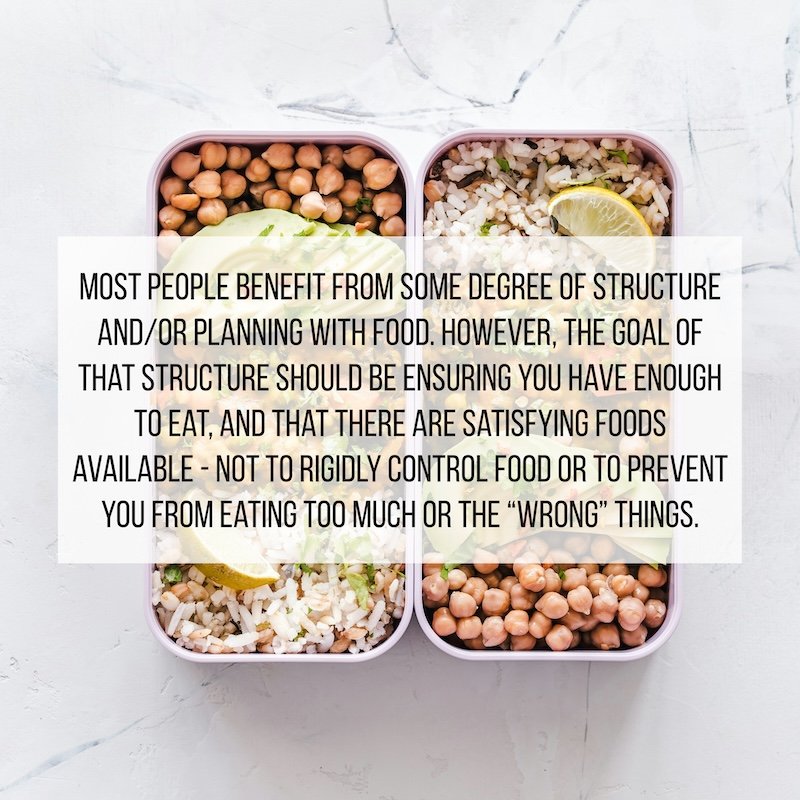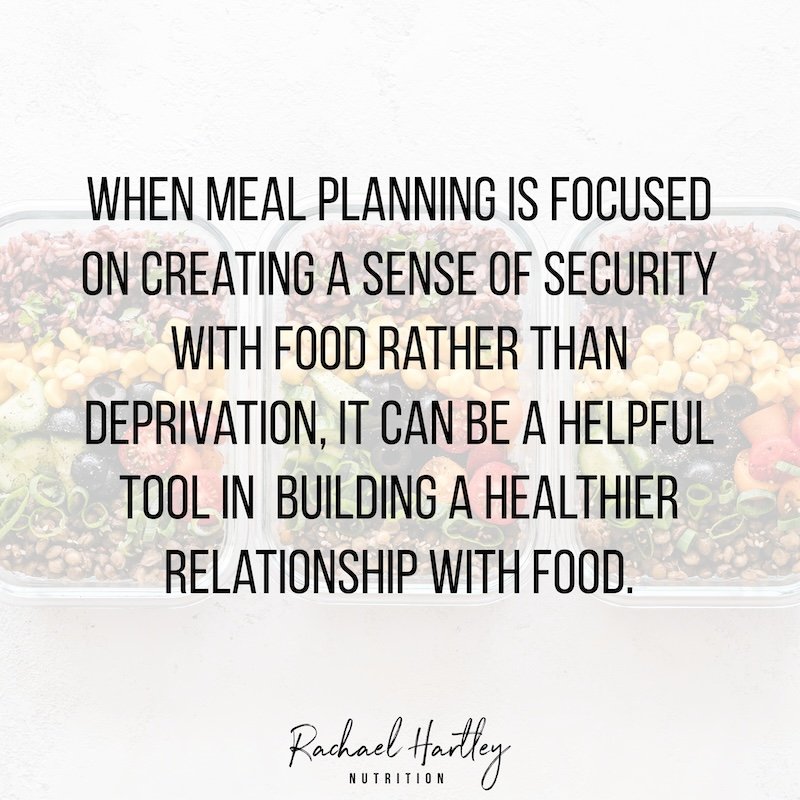My Favorite Meal Planning Strategy: How to Create a Master Menu for Meal Planning
Most people benefit from some degree of meal planning. However, the goal should be ensuring you have enough satisfying food to eat, not to rigidly control what you eat. This blog post shares a simple, non-diet tool you can use for meal planning in intuitive eating.
What comes to mind when you hear the phrase “meal planning.” Is it an image of meticulously packed and portioned meals in matching tupperware containers (am I the only one who doesn’t have a single matching set left in my house??)? Does each meal have some combination of food that involves at least two of the following: grilled chicken, salmon, brown rice, broccoli, Brussels sprouts, or roasted sweet potatoes?
If so, you’re not alone. For many of my clients who are healing from chronic dieting and disordered eating, meal planning is a four letter word. When I say they’ve been traumatized by the rigid and obsessive meal planning that many diets call for, I’m being only slightly hyperbolic. They’ve spent countless Sundays calculating macros, chopping and roasting vegetables, boiling brown rice, and grilling proteins to make sure they “stick to the plan” during the week. For them, meal planning = dieting, deprivation, rigidity, and restriction.
Understandably, some develop a bit of an aversion to meal planning, and when they let go of dieting, meal planning goes along with it. But without any meal planning, they often find themselves flying by the seat of their pants trying to feed themselves throughout the week. They come home from a long day at work, exhausted and hungry, open the fridge to see plenty of ingredients with zero idea what to cook with them. Eating ends up feeling more chaotic, unorganized, and impulsive than intuitive.
As I like to remind my clients, most people benefit from some degree of structure and/or planning with food. However, the goal of that structure should be ensuring you have enough to eat, and that there are satisfying foods available - not to rigidly control food or to prevent you from eating too much or the “wrong” things. When meal planning is focused on creating a sense of security with food rather than deprivation, it can be a helpful tool in building a healthier relationship with food.
Because so many of my clients have a negative perception of meal planning, I like to reframe towards meal preparedness. To me, meal preparedness communicates a sense of being prepared to feed yourself rather than rigid control. There’s a few tools I like to teach clients to support meal preparedness, but one of my favorites is a master menu.
What is a Master Menu?
A master menu is a list of all the different meals that you confidently know how to make, organized into categories that make sense for you and (if applicable) your family. Essentially, it’s a way to remember all the meals you find pretty tasty and satisfying, and can put together without a major headache.
Having a master menu can save a lot of time in meal planning. Instead of spending ages scrolling pinterest or thumbing through a cookbook for inspiration, or conversely, making the same ‘ole thing again and again because you can’t think of anything else, a master menu helps you more easily create an enjoyable plan for feeding yourself. For those who struggle with decision making (hello fellow ADHDers!), having a list of options is much easier than coming up with an idea on your own - think about the difference between taking a multiple choice test versus short answer!
A master menu can be helpful in identifying what foods you’re in the mood for. Sometimes it’s hard to know what sounds good, especially if you’re new to intuitive eating. When you’re looking at a list of foods (literally a menu!) you may find it easier to tap into what sounds tasty and satisfying.
Another thing I love about having a master menu is that it makes it easier troubleshoot any barriers to feeding yourself in advance. I’ll dive into this more in a second, but because you can organize your master menu into different categories, so you can pick and choose meals that address any needs that are coming up.
How to create a master menu
First, think about where it makes sense to keep your master menu. You might want to do it old school and have your list written down, but personally, I would suggest keeping it either in the notes app of your phone, or somewhere on your computer that’s easy to access and has the ability to add links if needed (great for people like me who still have to google “how to boil rice” every time!). If you’d like other people in the household to have access, consider something like a shared google doc.
Next, think about common barriers that arise when it comes to feeding yourself, then consider what type/category of meals might be helpful for you in those situations. Here’s a few examples:
For busy weeks, you might want to have a list of meals you can make in less than 15 minutes of preparation time, or meals you can throw together using convenience or snack foods - think of things like a frozen pizza and salad kit or a grilled cheese sandwich with canned soup (here’s a blog post with some quick and easy meal inspiration). Another idea for busy weeks might be recipes that make a lot of leftovers, leftovers you can repurpose, or dishes for meal prep.
If the number of people in the household changes from week to week (think children spending time with separate parents, a partner traveling for work, etc.), you can create separate lists of meal ideas to accommodate the different groupings. For example, there may be a hearty casserole that you and your kids love, but when your ex has them for the week, you might not want to live off leftovers of it for a week straight!
If you’re in eating disorder recovery, your capacity for eating fear foods might change week to week. You could create a list of “safer” feeling meals (that still meet your needs!) for weeks that are emotionally difficult, and another list of meals that incorporate fear foods you’re working on for weeks you feel more capable of stretching.
If finances are a challenge, consider a list of meals that are budget friendly for periods when money is tight.
If you have a chronic condition where your ability to tolerate or capacity for preparing food varies, create a list for that. For example, I have a client with fibromyalgia who experiences pretty intense stiffness and pain in her hands when it flares, so we have a list of meals that are easy to open and put on a plate. Another client has IBS, and we have a list of blander, more easily digestible foods for when his gut is being particularly wonky.
One category I tell everyone to keep on the list are pantry meals - meals that you can throw together with shelf/freezer/fridge-stable (or at least long lasting!) ingredients or staples. This allows flexibility, space to be more intuitive with food but still be prepared with ingredients you need to feed yourself. I encourage clients to always have the ingredients for 3ish pantry meals on hand at on time so they are able to easily throw something together when they’ve run out of fresh ingredients. I have a few ideas for pantry meals in this blog post on stocking a pantry for intuitive eating.
Finally, to make the master menu, brain dump all your meal ideas onto the list, categorizing them as you go. You might feel a bit paralyzed at first - I find people often freeze and can only think of one or two things. But when I start asking questions all sorts of ideas pop up. Here’s some questions to get your brain juices flowing…
What meals have you prepared over the past month?
Do a mental walk through the grocery store - does that bring up any ideas?
Think about meals you order when you go out to eat - are there dishes you can easily make at home?
What foods are in your fridge, freezer, and pantry right now - does it remind you of meals you often make?
What are meals that you used to eat that you haven’t made in a long time?
It’s OK if it’s hard to come up with ideas. Regularly come back to your master menu and add to it. This is a reason why it’s helpful to have your master menu on your phone, because you might think of an idea when you’re out and about.
Another reminder - resist the urge to make every option on the list a “healthy” one. Remember, a master menu is not to control eating, but to make it easier for you to get yourself fed. If you notice yourself not putting a meal on the list because you think you should be eating it less often, remember that part of putting a dish on the master menu is normalizing that food and making it less of a forbidden fruit. It’s not helpful to have a master list full of ideas you think you should eat but don’t actually enjoy!
How to use a master menu
Each week (or however often you grocery shop), look at your master menu and pick a few options, then make a grocery list for whatever ingredients you need. How many dishes and which categories you choose from will vary week to week depending on what’s going on in life. I think it’s a smart idea to pick one less option than you’ll need for the number of days, then fill in the gaps with pantry meals, takeout, or going out to eat. This way you’ll have flexibility in your week if plans arise, and won’t feel overwhelmed with food you need to use before it goes bad. For example, last week when my husband was out of town, I knew I had 10 open lunches and dinners to plan for, so I picked two dishes that made about 4ish servings each, then filled in the gaps by picking up a sandwich and a freezer meal.
When meal planning for the week, you don’t have to only pick meals from the master menu. The idea of the master menu is not that you only eat foods off the list. It’s a tool to help you be more prepared with ideas for what’s relatively easy and enjoyable, and to anticipate challenges to feeding yourself in advance. If you’re someone who likes trying new things, you might want to pick a combination of new recipes and items off your master menu when you go shopping.
Another way to include variety while using a master menu is to think of the dishes on your master menu as templates, where you can mix and match spices, sauces, or other ingredients to keep things interesting. For example, one of the meals on my list is a frittata with roasted potatoes. I have a basic frittata recipe that I’ve pretty much mastered, but I’ll often switch it up with different ingredients based on what ingredients I’m trying to use up, or what flavors I’m in the mood for.
The bottom line on using a master menu for meal planning
I hope this master menu meal planning tool is helpful for you. If not, that's OK! Different methods work for different people, so this master menu tool might not connect with you. Feel free to pull from this method anything that does feel like it can support you in feeding yourself more confidently.
If you’re someone who struggles with meal planning, I also have an entire chapter on meal planning for intuitive eating in my book, Gentle Nutrition, that I’ve heard has been really helpful for a many readers. In it, I go more in depth with how to plan meals for satisfaction, and fostering healthy habits with food. If you need more support figuring out a sustainable, stress-free way of feeding yourself, we work with clients throughout the US and in our Columbia, SC office. Check out my practice philosophy, and just reach out if you have any questions!







